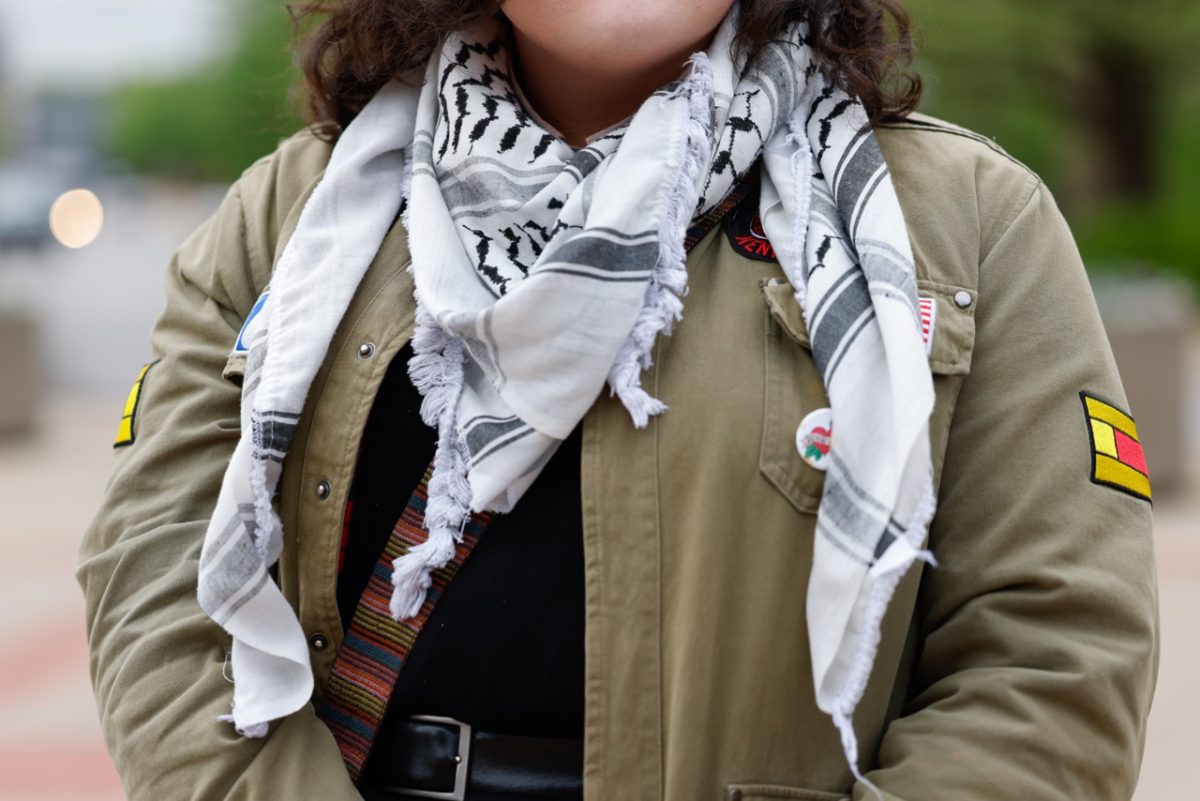At the University of Missouri, protest lives on backpacks and jackets. It is stitched into patches, clipped onto bags and stuck across laptops. A keffiyeh, a traditional Arab headdress often used as a symbol for Palestinian resistance, signals solidarity. A rose nods to socialism. These are not just fashion statements; they are values worn in plain sight.
For a generation fluent in visual storytelling and digital shorthand, students are turning to visual expression to convey their beliefs.
Wearing your beliefs is not exactly new, and students have long used their bodies as canvases for protest — from the black armbands in Tinker v. Des Moines to the polished suits of the Greensboro Four. Quiet defiance stitched into clothing has always had the power to speak volumes.
However, this practice has evolved over time. Stickers on laptops, pins on backpacks and thrifted clothing with a message are nearly universal. It is hard to find a student who does not wear at least one marker of their beliefs or identity.
This shift reflects more than just an aesthetic preference — it reveals how protest has moved inward from occupying physical spaces to inhabiting the body itself.
At MU, this evolution is shaped in part by the university’s history. After the 2015 protests led by Concerned Student 1950, the university adopted stricter anti-camping policies, which banned encampments on campus grounds.
In the years since, some of that bold, physical presence — the willingness to stake out space in protest — has been dismantled. This begs the question: when you can no longer build a protest site, where does the protest go?
Anna Fett, an assistant professor of peace studies and Black studies, said that examining how younger generations adapt to the changing landscape of protesting is interesting.
“If you are not allowed to have a site on university property, you may have to get creative,” Fett said. “In order to keep your hands free, you may end up considering wearing parts of your messaging that you wouldn’t have had to wear before.”

His belongings are brimming with political meaning; a rose-shaped pair of earrings symbolizing the socialist movement, a jacket used during protests in Chile passed down from a friend and his uncle’s shirt from the ‘90s declaring “Free Palestine.” Beyond their symbolism, these items carry personal history, and De Smet said their origins create even more depth and attachment to his own self.
“For me, while there is some element of intentionality [in choosing these items], it’s mostly elements that are tied to others and those experiences that I’ve shared with them.” De Smet said.
These visible markers of belief start conversations as much as they make statements. De Smet recalled how his “Free Palestine” shirt sparked chance encounters that led him to join student organizations like YDSA and Mizzou Students for Justice in Palestine.
It is in those small moments — a passing compliment or a smile of recognition — that a deeper sense of solidarity begins to form.

MU first-year student and YDSA member Lily Dunn carries many physical symbols of her ideologies, using
punk-style battle jackets to create something truly representative of herself.
Dunn said her choices in her physical presentation act as a kind of allegiance she hopes will help others feel safe.
“[These items] can kind of create a patchwork that shows your ideology,” Dunn said. “By wearing these political symbols, it’s trying to signal that I am safe.”
But solidarity on campus is not always easy to cultivate. While full of potential for dialogue, college spaces can also be fractured by rigid ideologies and the pressure to conform. For those who are politically active or hold marginalized views, it can be difficult to break from what’s expected, to challenge the quiet pressure to stay neutral and remain silent.
These small acts of acknowledgment offer steps for change; whether through awareness or affirmation, students are able to feel seen, supported and less alone in their beliefs.
“The truth is, as much as an institution can tell us that we are accepted, it’s that acceptance from our peers that really matters the most,” De Smet said. “Once you get through that hard obstacle of making those first steps, it really becomes such a unique community.”

Student activism does not have to be a loud declaration —there are many ways to quietly express what you think. In a political climate where public demonstrations can be policed or dangerous, this form of protest remains accessible and adaptable, allowing students to carry their convictions with them.
Edited by Molly Levine | [email protected]
Copy edited by Stella Spragg and Natalie Kientzy | [email protected]
Edited by Emilia Hansen | [email protected]
Edited by Annie Goodykoontz | [email protected]






